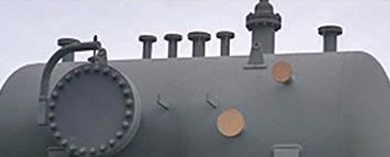
- (03) 5909 8218
- enquiry@fusionweld.com.au
Innovating the flash-tank condenser model
January 30, 2015

The principles of steam conservation are a mix of low and high pressure characteristics as dictated by the condensation of water from one state to another. Fluid dynamics and gaseous states interact with fabricated vessels, pipes and conduits, changing state within precisely manufactured chambers to trigger boiling and vaporization trends, re-evaporating when required. It's a super-heated environment that's every bit as challenging as that encountered in the oil and gas industry, one that requires high-end engineering practices.
The flash point of steam is considered an important function in the boiler industry due to the relationship between pressure and the laws of physics that govern the change of state from liquid to gas and back again. In other words, the energy required to vaporize water is affected by an energy source, but it's also readily manipulated by the introduction of intelligently sized vessels in the flow. The larger capacity of the vessel equals a dramatic reduction in pressure, a drop that immediately causes the stream to 'flash' or dynamically evaporate. Logically, the same cycle will work in reverse, using the combination of rising steam and gravity to return the evaporated steam back to a distilled form as it condensates on the higher ridges of the chamber.
Mathematical equations and complex graphical translations of these calculations exist as curves to guide the competent engineer in defining the vacuum required in a sealed chamber, the quantities of latent and sensible heat used to coordinate critical thermal functions, and to use these figures to manufacture the physical assemblies that trap and funnel the various states of energy-transmitting water. The flash tanks task in this complex framework of high-pressure and low-pressure pipes and chambers is to 'flash' high-pressure condensate, water that would become steam at atmospheric pressure, back into steam. The steam is then stored and passed on to heating systems and other applications, such as a number of powerful steam turbines in a power station.
A dual application that is currently being investigated by research and development divisions is the addition of a desalination plant to this steam generator setup. Excess steam can be passed on to a heat recovery steam generator and flashed in a high-capacity tank to separate distilled water from salt. Feasibility studies and small models will eventually become large-scale working plants, combining with osmosis and filtration technology to bring fresh water to struggling nations.
The enthalpy of liquid at lower pressures and the evaporating 'flash' of water to steam as it changes state in the near atmospheric pressure chamber of the flash tank is one-hundred percent efficient in an ideal system, but real life considerations, heat absorption through metal and cladding, suggest the need for a reduction valve to augment flashed steam.
Contact Details
Fusion - Weld Engineering Pty Ltd
ABN 98 068 987619
1865 Frankston Flinders Road,
Hastings, VIC 3915
Ph: (03) 5909 8218
Optimized by NetwizardSEO.com.au
Recent Posts
- Compressed Hydrogen Storage Vessels: Material Selection, Design & Australian Standards
- Welding QA/QC in Oil & Gas Pressure Vessel Fabrication – Ensuring Code Compliance
- AS1210 vs ASME VIII Pressure Vessel Code: Key Differences for Australian Projects
- Mitigating Hydrogen-Induced Cracking in Pressure Vessels: Engineering and Material Strategies
- Storage Tank Solutions Australia: Field-Erected, Prefabricated & Self-Bunded Explained
- Reducing Environmental Risks: Self-Bunded Tanks in Australian Oil & Gas Operations
- Precision in Production: How Pressure Vessels Are Manufactured for Industrial Safety
- Shell & Tube Heat Exchangers: Improve Thermal Control & Energy Recovery in Petrochemical & Pharmaceutical Plants
- In-Service Inspection for Compressed Air Receivers for Power Plant Shutdown Prevention
- Power Plant Pipe Spooling Fabrication – Get Rapid, Code-Compliant Spools Ready for Installation
- Field Erected Tanks: Safe, Reliable On-Site Fuel Storage Solutions in Australia
- Custom Pressure Vessel Fabrication for Flammable Gases
Posts 2025
- Compressed Hydrogen Storage Vessels: Material Selection, Design & Australian Standards
- Welding QA/QC in Oil & Gas Pressure Vessel Fabrication – Ensuring Code Compliance
- View all articles…
Posts 2024
- Large Process Vessels: Optimising the Design for Maximum Efficiency [2025]
- Pressure Equipment Management System Installation: Detect Equipment Faults Early
- View all articles…
Posts 2023
- Pressure Piping System Inspection: A Gift of Safety for the Holidays
- Deaerator Inspections by Fusion-Weld Engineering and How They Reduce System Downtime
- View all articles…
Posts 2022
- How Fusion Weld Keeps Up With AS-NZS ISO 9001:2008 Standard
- Boiler Equipment Safety Inspection During the Summer Season
- View all articles…
Posts 2021
- Avoid These Factors and Practices that Contribute to Sealing Damage in Pressure Vessels
- Do's And Don'ts Of Industrial Boiler Inspection And Maintenance From Fusion-Weld
- View all articles…
Posts 2020
- What are the Risks and Hazards Involved in Pressure Vessel Equipment?
- How to Know if Your Pressure Equipment Needs Repair or Replacement?
- View all articles…
Posts 2019
- Factors that Contribute to Pressure Vessel Failure
- Pressure Vessel Regulations in Australia: What are the Mandatory Requirements?
- View all articles…
Posts 2018
- Pros and Cons of Spherical vs. Cylindrical Pressure Vessels
- What are the Different Hazard Levels in Pressure Vessels?
- View all articles…
Posts 2017
- Transportable Pressure Vessels: The Importance of Inspection and Safety Checks
- Fracture Mechanics and Stress Analysis of Cracks in Pressure Vessels
- View all articles…
Posts 2016
Posts 2015
- What Are Deaerators & Feedwater Vessels?
- Precautions and Safety for Compressed Air Receiver Vessels
- View all articles…
Posts 2014
- Demonstrating In-process Inspection Procedures
- Static Grounding Practices and Standards
- View all articles…